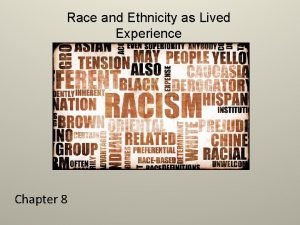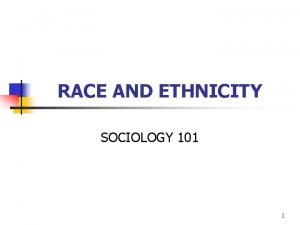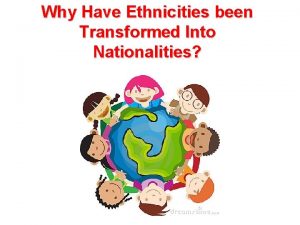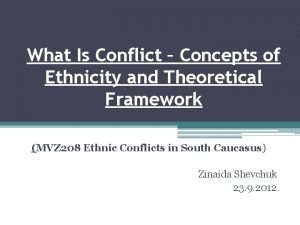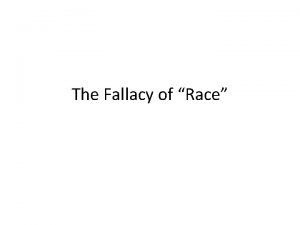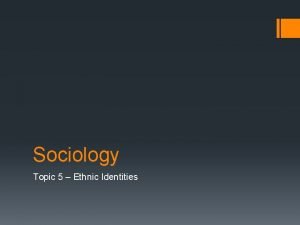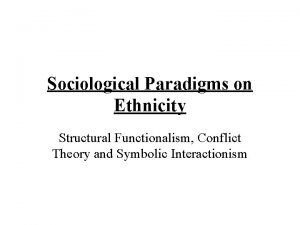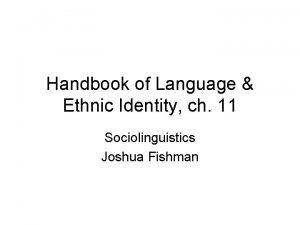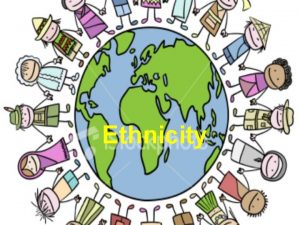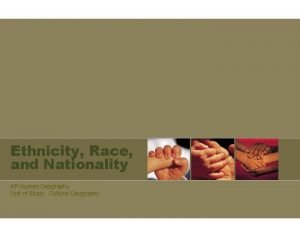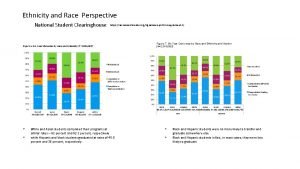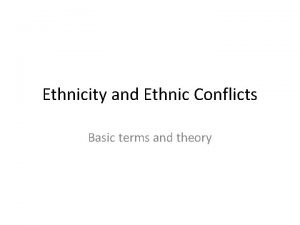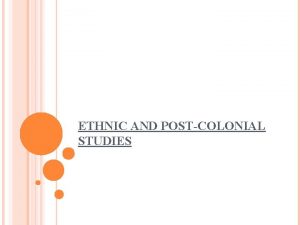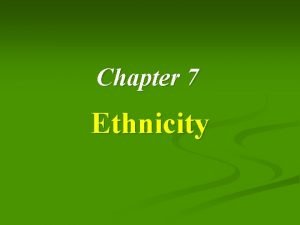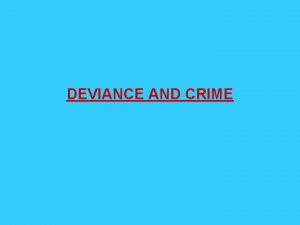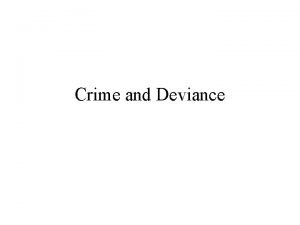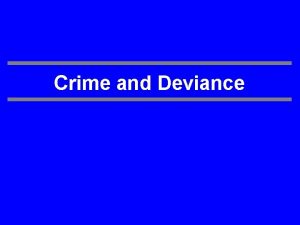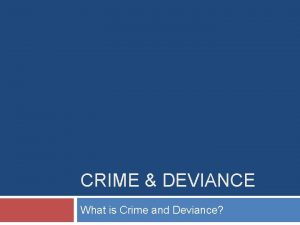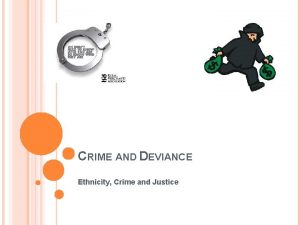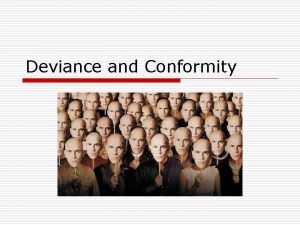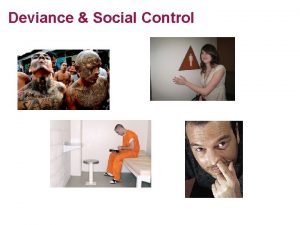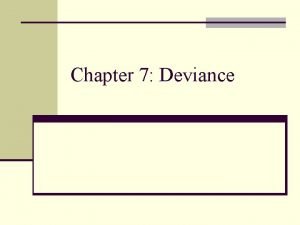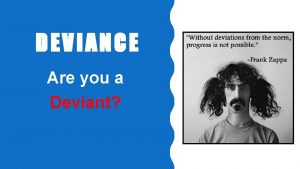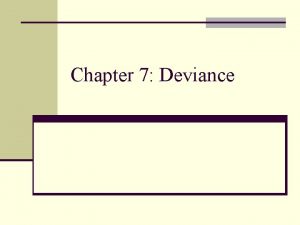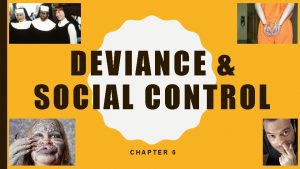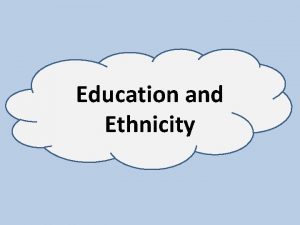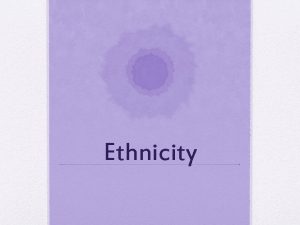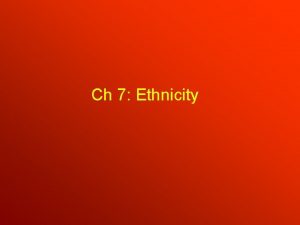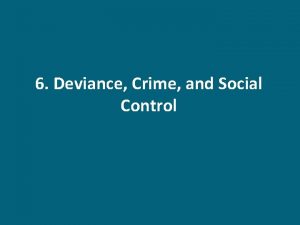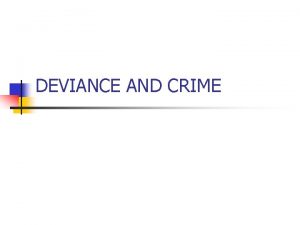Ethnicity and Crime Unit 4 Crime and Deviance























- Slides: 23

Ethnicity and Crime Unit 4: Crime and Deviance Exam style question: ‘Assess Sociological explanations for the over-representation of some minority ethnic groups in criminal statistics’

an also c h ic h w D & C f o s theorie r e h t o h it w r ia il m fa D. & C & y it You should also be ic n h t E o t n C&D & be applied in relatio y it ic n h t E f o y d u t to the s s ie r o e h t g in w o ll fo ØApply each of the his) t o d u o y s a s ie r o e (evaluate th (Merton) ie m o n A & y r o e h Strain T Ecology Theory hlin) loward & O (C s e s s la -C g Workin e h t & s e r u lt u c b u S And cerns (M n o C l a c o F s s la -C g Workin iller)

The ‘facts’ • • • 91% of people in the UK are white 9% are non-white 5% Asian 2% Afro- Caribbean 2% mixed and other

Ethnicity & Crime • Of the 80, 000 men in prison approximately 74% are white, 15% Afro-Caribbean, 7% Asian, 3% mixed and 1% Chinese. • Of the 7, 000 women in prison 70% are white, 21% Afro-Caribbean, 5% mixed, 2% Asian and 2% Chinese and other. • The situation in the USA is very similar – Black Americans make up 13% of the total population and 50% of the prison population.

Offending 2000/01

In 2008, the Ministry of Justice reported that, compared to white people: Afro Caribbean's were: • more likely to be arrested for robbery • three times more likely to be cautioned by the police • three and a half times more likely to be arrested; if arrested, more likely to be charged and face court proceedings than to receive a caution • more likely, if found guilty, to receive a custodial (prison) sentence; five times more likely to be in prison. Asians were • twice as likely to be stopped and searched (mainly for drugs) • more likely to be charged and face court proceedings than to receive a caution • more likely to receive a custodial sentence if found guilty; more likely to be arrested for fraud and forgery.

Victims of Crime • Ethnic minorities are also more likely to be victims of crime disproportionately to their numbers, and this is particularly s for ethnic minority women. Why do you think this is the case?

Ethnicity And Victimisation The BCS (British Crime Survey) and victim surveys are the main providers of information about the type and incidence of racially motivated crimes Most recorded racist incidents are crimes against property and verbal harassment Most incidents are unreported

Victimisation • The murder of Stephen Lawrence and the failure of the criminal justice system to convict those responsible led to an official enquiry www. news. bbc. co. uk/1/hi/uk/285553. stm • Macpherson Report (1999) found serious failings with the police investigation • It raised two questions: 1. Is the criminal justice system unbiased? 2. Are ethnic minority groups more likely to be victimised than the White majority?

Reasons for Criminality • There are two main strands of thought as to why ethnic minorities are more likely to be seen as criminals and be victims of crime. • They are: – Structuralist views: They are more criminal – Social Constructionist views: The justice system is unfair

Reasons for High criminality of Afro-Caribbean (Structural) • Lea & Young (left realists) – first criminologists to acknowledge that black people were not simply victims of a racist police force and criminal justice system but are actually more likely to be involved with street crime than whites. Marginalisation Reasons Relative Deprivation Sub cultural response

Other reasons for higher rates of street crime amongst blacks Educational success • 2006 – only 23% of Afro-Caribbean boys achieved 5 GSCE’s • Affects selfconfidence, employability (think Merton and sub cultural theorists) Family Structure Mass Media • 60% of young black males live with just one parent (normally the mother) • Single parent families also tend to be poorer than nuclear families so the link could be related to poverty as well • According to some New Right and conservative thinkers ‘Rap music’ encourages ‘CRIMINALITY’ • This view has been challenged because it is questionable to simply blame one form of entertainment

Crime among other minorities. • Don’t underestimate the impact of a declining influence of religion in the lives of some minority groups. • In addition you could refer to a rise in some forms of fundamentalism (which is linked with terrorism and criminal activity. Linked with globalisation when you refer to countries such a Yemen, Afghanistan etc).

On the other side of the argument …. • The over-representation of Afro-Caribbean's in crime statistics is a social construct, created as a result of discrimination towards blacks and Asians by the police and other criminal justice agencies. There is considerable evidence of racist views held by police officers.

Unfair Treatment and Racism • Reiner (2000): Canteen culture amongst the police, including: suspicion, macho values and racism, which encourages racist stereotypes and a mistrust of those from non white backgrounds. • Bowling and Phillips (2002): Higher levels of robbery among black people could be the product of labelling that arises from the use of regular stop and search procedures, which in turn leads to the self fulfilling prophecy.

Sharp and Budd (2005) • Black offenders were most likely to have contact with the criminal justice system in their lifetime and were more likely to have been arrested, been to court and convicted. This is despite their lower levels of offending compared to white people generally and white youths in particular. • Black and Asian offenders are more likely to be charged rather than cautioned, remanded rather than bailed, given prison sentences rather than probation/communitity punishment compared to white people. This suggests that they are treated unfairly by the criminal justice system.

Waddington (2004) • Published in the British Journal of Criminology argues that the police do stop a proportionately higher number of blacks compared to whites. • However, he argues that there are more ethnic minority youths out at night in inner cities and that the police simply target those in high risk areas. If the areas is disproportionately represented by young black males they are more likely to be stopped and searched – because of where they are rather than their ethnicity

Test Your Knowledge • What are the trends linking ethnicity and crime? • What is black criminality? • What is the link between the police and institutional racism?

The Political nature of Black Crime (Gilroy) • A Neo-Marxist who agrees that young blacks are targeted by the media and the police, but argues that black crime is different in that it is a conscious continuation, in a new context, of anti-colonial struggles in the West Indies. • It is therefore political and potentially revolutionary, a political response to inequality and discrimination. • Rastafarianism, for example, is not just a religion; it contains a set of revolutionary political ideas about overthrowing white authority (“Babylon”), and tends to bring its followers into confrontation with the police over, for example, marijuana use.

Evaluation (AO 2) • It has often been claimed that black crime is no higher than crime by the majority, that the official statistics reflect discriminatory practices by the police and courts. Sometimes questioning this claim can be presented as racist. • On the other hand, however, and sometimes in the same accounts, it is claimed that high rates of some crimes, especially street crimes, are to be expected, part of the survival strategy of a reserve army of labour which finds itself unwanted, an understandable response to disadvantage and discrimination. • Like other Marxists studying crime, Gilroy can be seen as reading meanings which may not be there into the behaviour of young blacks; they are unlikely to agree with his explanation of their behaviour.

Conclusion • Institutional Racism • Structural factors • Ethnicity may just be one element in a complex web of courses. • Should never neglect power relations. • Should consider which social groups have the most power in creating and enforcing the law.

Key facts Official statistics say black people are: Ø 7 times more likely to be stopped and searched. Ø 3 ½ times more likely to be arrested. Ø 5 times more likely to be in prison than their white counterparts. Ø Victim studies say black people are more likely to be identified as offenders & most crime is intra –ethnic meaning it takes place among rather than between ethnic groups. Ø Self-report studies conclude that black people have similar rates of offending to whites if not lower. Ethnicity and the criminal justice system 2. Stop and search Lots of stop an search is perhaps due to racism and the targeting of ethnic minorities. Ethnicity and crime 4. Prosecution & conviction Crown prosecution Service more likely to drop cases against ethnic minorities. Black and Asian defendants are less likely to be found guilty. 1. Policing Many allegations of oppressive policing from minority ethnic communities are made. 3. Arrests and cautions More likely to be arrested and cautioned perhaps due to a mistrust of police and not admitting to the offence. 5. Sentencing and Prison Custodial sentences more likely to be given to black offenders. Blacks and Asians over-represented in prisons and more likely to be given longer sentences.

Explaining differences in offending Left realism: Ethnic minorities commit more crime because racism in wider has caused them to be marginalised, coupled with economic exclusion such as high unemployment and poor housing. Left realists don’t believe that racism in the police can account for higher crime because black people have a higher offending rate than Asians. Stephen Lawrence The death of Stephen Lawrence in 1993 by a white gang caused outcry as police botched the investigation. The inquiry called the Macpherson report declared institutional racism in the police. Neo-Marxist - Paul Gilroy Black people commit more crime because they resent the cultural experience of colonialism i. e. being taken over and having black slaves sent to Britain to work. This experience causes resentment in young black males which makes them commit crime. Ethnicity and crime Victimisation Police recorded 61, 000 racists incidents while the BCS reports 184, 000 many go unreported. People from mixed ethnic backgrounds were more likely to be victims of crimes. Neo-Marxist - Stuart Hall et al (Policing the crisis) ØCombines Marxism and Labelling theory. ØEconomic conditions in the 1990’s were bad, government look for a scapegoat. ØYoung black muggers are labelled and a moral panic is created about their behaviour in the media. ØYoung black males commit no more crime than any other group but labelling and the economy makes it seem like they do.
 Logistic regression residual deviance
Logistic regression residual deviance Crime and deviance sociology revision
Crime and deviance sociology revision Chapter 7 deviance crime and social control
Chapter 7 deviance crime and social control Difference between crime and deviance
Difference between crime and deviance Crime and deviance definition
Crime and deviance definition Marxism crime and deviance
Marxism crime and deviance Chapter 8: race and ethnicity as lived experience
Chapter 8: race and ethnicity as lived experience Assimilation culture
Assimilation culture Stateless-nation
Stateless-nation What is ethnicity
What is ethnicity Troian bellisario ethnicity
Troian bellisario ethnicity What is ethnicity
What is ethnicity What is a structural functionalism
What is a structural functionalism Symbolic ethnicity
Symbolic ethnicity Ethnicity in sociolinguistics
Ethnicity in sociolinguistics Lactose intolerance by country
Lactose intolerance by country What is ethnicity
What is ethnicity Ethnicity examples
Ethnicity examples Ethnicity definiton
Ethnicity definiton Ethnicity in postcolonial literature
Ethnicity in postcolonial literature Whats ethnicity mean
Whats ethnicity mean Pitaras russian
Pitaras russian Taylor swift's blood type
Taylor swift's blood type Porter novelli healthstyles survey
Porter novelli healthstyles survey






